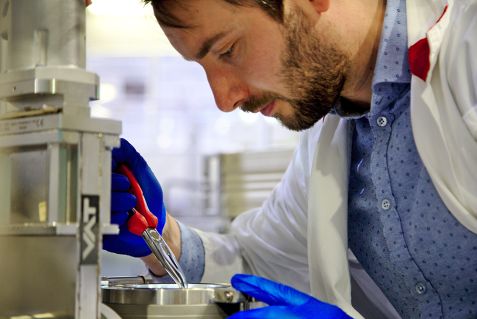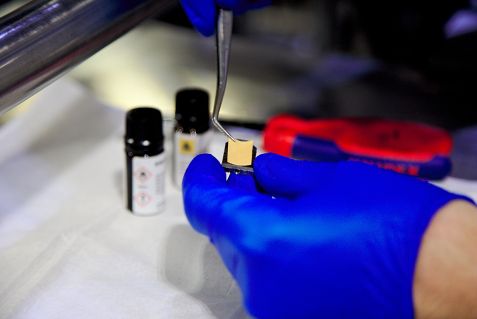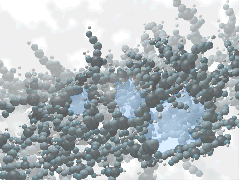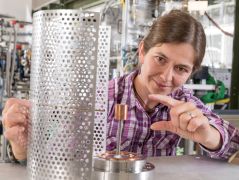MLZ is a cooperation between:
 > Technische Universität München
> Technische Universität München > Helmholtz-Zentrum Hereon
> Helmholtz-Zentrum Hereon
 > Forschungszentrum Jülich
> Forschungszentrum Jülich
MLZ is a member of:
 > LENS
> LENS > ERF-AISBL
> ERF-AISBL
MLZ on social media:

MLZ (eng)
Lichtenbergstr.1
85748 Garching
23.07.2021
Using antimatter to improve wastewater cleaning

Dr. Marcel Dickmann places the membrane on a sample plate to study it by positron annihilation lifetime spectroscopy. © Markus Singer
Who would want to drink residues of detergents or medicines? Researchers from Belgium and the Netherlands used positrons, the antiparticles of electrons, at the Heinz Maier-Leibnitz Zentrum to study membranes designed to filter precisely such micropollutants from wastewater.
Clean drinking water is a precious resource, especially in southern hemisphere countries. When there is not enough fresh water, water treatment plants purify wastewater so that it is drinkable. Huge plants filter wastewater through a partially permeable membrane that traps dirt particles and salt. “One risk with these membranes is that organic micro- and nano-pollutants slip through during filtration,” says Dr. Marcel Dickmann. These are synthetically produced substances, such as residues from detergents or medications. “For example, organic micropollutants include the well-known painkiller paracetamol,” Dickmann explains.
Marcel Dickmann from the Universität der Bundeswehr München operates the so-called positron annihilation lifetime spectroscopy (PAES) instrument at the world’s strongest positron source NEPOMUC (Neutron-Induced Positron Source Munich). Behind the bulky name hides an experimental apparatus on barely four square meters in the experimental hall of the FRM II. This is the first time Dickmann has used positrons to examine a wastewater filter membrane for its ability to filter out organic micropollutants. They are thumbnail-sized rectangular platelets that look a bit like coffee filter paper.
Pore size studied at micrometer level

The samples of the membrane are thumbnail-sized rectangular platelets that look a bit like coffee filter paper. © Markus Singer
Researchers from the Netherlands and Belgium developed this membrane. Earlier studies had tested the general permeability of the membrane. It quickly became clear that the smaller the pores in the membrane, the more likely it was that micro-pollutants would stick. In the new study, the researchers sharpened their focus: “We went down to the micro and nanometer level and looked at the individual pores of the membrane,” says Dickmann. To do this, the team of scientists brought membranes with different pore sizes, different thicknesses, and from different manufacturing processes to the positron source in Garching.
Non-destructive measurement with positrons
Dickmann bombarded the membranes with positrons. As soon as a positron interacts with an electron, it forms positronium, which emits radiation after a certain time. Dickmann can measure this radiation with his apparatus. The smaller the pore in the membrane, the faster the positronium emits the radiation. The pore size of the membrane can thus be determined via the lifetime of the positronium. “No other method can determine the pore size so precisely without destroying the membrane,” Dickmann said. The researchers from Belgium and the Netherlands needed the size of the pores for their studies. In this way, they were able to draw conclusions as to which manufacturing processes provide the appropriate pore sizes. Another result surprised the researchers: The thicker the membrane, the more permeable it was to pollutants.
Marcel Dickmann is certain: “The study will help improve the design of wastewater filters.” After all, residues of medicines or detergents have no place in drinking water.
Original publication:
Roman, M., Roman, P., Verbeke, R., Gutierrez, L., Vanoppen, M., Dickmann, M., Egger, W., Vankelecom, I., Post, J., Cornelissen, E., Keesman, K., Verliefde, A., Non-steady diffusion and adsorption of organic micropollutants in ion-exchange membranes: effect of the membranethickness, ISCIENCE (2021), DOI: 10.1016/j.isci.2021.102095
Related News
-
15.04.2021
Using antimatter to combat plastic waste
-
15.12.2018
Trapped antimatter
MLZ is a cooperation between:
 > Technische Universität München
> Technische Universität München > Helmholtz-Zentrum Hereon
> Helmholtz-Zentrum Hereon
 > Forschungszentrum Jülich
> Forschungszentrum Jülich
MLZ is a member of:
 > LENS
> LENS > ERF-AISBL
> ERF-AISBL
MLZ on social media:




